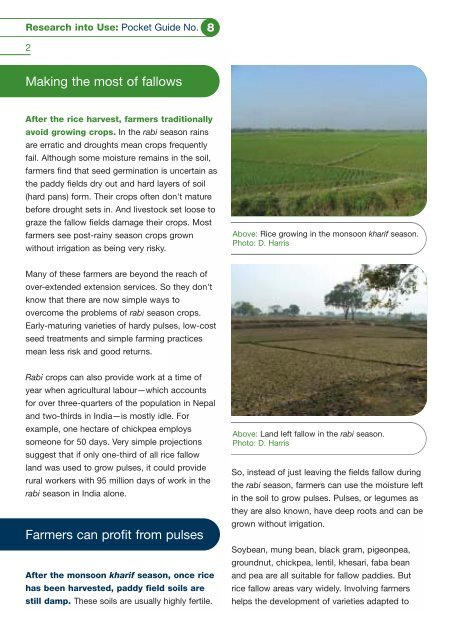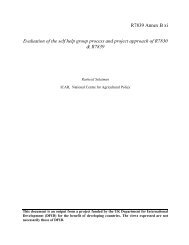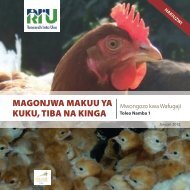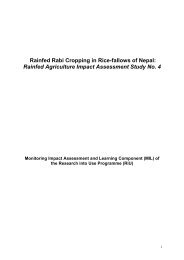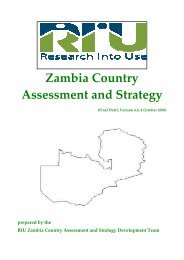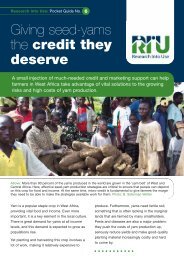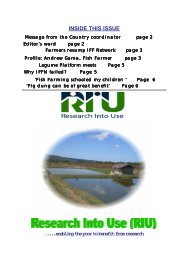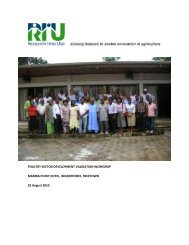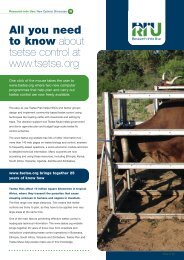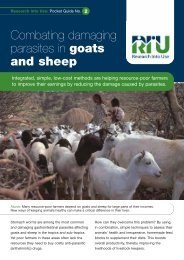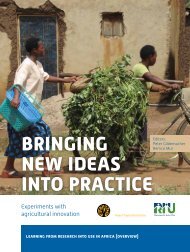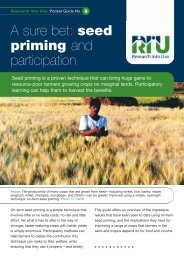Profitable pulse crops transform rice fallows RIU Pocket Guide 8
Profitable pulse crops transform rice fallows RIU Pocket Guide 8
Profitable pulse crops transform rice fallows RIU Pocket Guide 8
You also want an ePaper? Increase the reach of your titles
YUMPU automatically turns print PDFs into web optimized ePapers that Google loves.
Research into Use: <strong>Pocket</strong> <strong>Guide</strong> No. 8<br />
2<br />
Making the most of <strong>fallows</strong><br />
After the <strong>rice</strong> harvest, farmers traditionally<br />
avoid growing <strong>crops</strong>. In the rabi season rains<br />
are erratic and droughts mean <strong>crops</strong> frequently<br />
fail. Although some moisture remains in the soil,<br />
farmers find that seed germination is uncertain as<br />
the paddy fields dry out and hard layers of soil<br />
(hard pans) form. Their <strong>crops</strong> often don't mature<br />
before drought sets in. And livestock set loose to<br />
graze the fallow fields damage their <strong>crops</strong>. Most<br />
farmers see post-rainy season <strong>crops</strong> grown<br />
without irrigation as being very risky.<br />
Above: Rice growing in the monsoon kharif season.<br />
Photo: D. Harris<br />
Many of these farmers are beyond the reach of<br />
over-extended extension services. So they don't<br />
know that there are now simple ways to<br />
overcome the problems of rabi season <strong>crops</strong>.<br />
Early-maturing varieties of hardy <strong>pulse</strong>s, low-cost<br />
seed treatments and simple farming practices<br />
mean less risk and good returns.<br />
Rabi <strong>crops</strong> can also provide work at a time of<br />
year when agricultural labour—which accounts<br />
for over three-quarters of the population in Nepal<br />
and two-thirds in India—is mostly idle. For<br />
example, one hectare of chickpea employs<br />
someone for 50 days. Very simple projections<br />
suggest that if only one-third of all <strong>rice</strong> fallow<br />
land was used to grow <strong>pulse</strong>s, it could provide<br />
rural workers with 95 million days of work in the<br />
rabi season in India alone.<br />
Farmers can profit from <strong>pulse</strong>s<br />
After the monsoon kharif season, once <strong>rice</strong><br />
has been harvested, paddy field soils are<br />
still damp. These soils are usually highly fertile.<br />
Above: Land left fallow in the rabi season.<br />
Photo: D. Harris<br />
So, instead of just leaving the fields fallow during<br />
the rabi season, farmers can use the moisture left<br />
in the soil to grow <strong>pulse</strong>s. Pulses, or legumes as<br />
they are also known, have deep roots and can be<br />
grown without irrigation.<br />
Soybean, mung bean, black gram, pigeonpea,<br />
groundnut, chickpea, lentil, khesari, faba bean<br />
and pea are all suitable for fallow paddies. But<br />
<strong>rice</strong> fallow areas vary widely. Involving farmers<br />
helps the development of varieties adapted to


